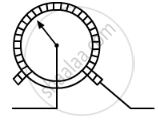Advertisements
Advertisements
प्रश्न
A copper wire has diameter 0.5 mm and resistivity of 1.6 × 10−8Ω m. What will be the length of this wire to make its resistance 10 Ω? How much does the resistance change if the diameter is doubled?
उत्तर
Given diameter of the wire,
D = 0.5 × 10−3 m
resistivity of copper, ρ = 1.6 x 10−8 ohm m required resistance, R = 10 ohm
As R = `(ρl)/A, l = (RA)/ρ = (R((piD^2)/4))/ρ = (πRD^2)/(4ρ)` ...`[∵ A = pir^2 = pi(D/2)^2 = (piD^2)/4]`
∴ `l = (3.14 xx 10 xx (0.5 xx 10^-3)^2)/(4 xx 1.6 xx 10^-8)`
m = 122.7 m
Since `R = (ρl)/((πD^2)/4)`
= `(4ρl)/(πD^2), R∝1/D^2`.
When D is doubled, R becomes `1/4` times.
APPEARS IN
संबंधित प्रश्न
What is (a) the highest, (b) the lowest total resistance that can be secured by combinations of four coils of resistance 4 Ω, 8 Ω, 12 Ω, 24 Ω?
Why are copper and aluminium wires usually employed for electricity transmission?
Fill in the following blanks with suitable words:
Copper is a good .......... Plastic is an ..........
What is meant by conductors and insulators? Give two examples of conductors and two of insulators.
Distinguish between good conductors, resistors and insulators. Name two good conductors, two resistance and two insulators.
Name the electrical property of a material whose symbol is "omega".
Which has more resistance:
a long piece of nichrome wire or a short one?
What will be the resistance of a metal wire of length 2 metres and area of cross-section 1.55 × 10−6 m2 if the resistivity of the metal be 2.8 × 10−8 Ω m?
Give two examples of substances which are good conductors of electricity. Why do you think they are good conductors of electricity?
What would be the effect on the resistance of a metal wire of:
increasing its length?
What would be the effect on the resistance of a metal wire of:
increasing its temperature?
How does the resistance of a wire change when:
its material is changed to one whose resistivity is three times?
The figure blow shows a variable resistor in a dimmer switch.

How would you turn the switch to make the lights: (a) brighter, and (b) dimmer? Explain your answer.
Resistance of a metal wire of length 5 m is 100 Ω . If the area of cross - section of the wire is `3 × 10^-7 "m"^2` , Calculate the resistivity of the metal .
Materials which allow larger currents to flow through them are called:
The element used almost exclusively for filaments of incandescent lamps:
Assertion: Conductors allow the current to flow through themselves.
Reason: They have free charge carriers.
Use the data in the Table given below to answer the following –
Which material is the best conductor?
Table give below Electrical resistivity of some substances at 20°C
| Electrical resistivity of some substances at 20°C | ||
| − | Material | Resistivity (Ω m) |
| Conductors |
Silver | 1.60 × 10−8 |
| Copper | 1.62 × 10−8 | |
| Aluminium | 2.63 × 10−8 | |
| Tungsten | 5.20 × 10−8 | |
| Nickel | 6.84 × 10−8 | |
| Iron | 10.0 × 10−8 | |
| Chromium | 12.9 × 10−8 | |
| Mercury | 94.0 × 10−8 | |
| Manganese | 1.84 × 10−6 | |
| Alloys |
Constantan (alloy of Cu and Ni) |
49 × 10−6 |
| Manganin (alloy of Cu, Mn and Ni) |
44 × 10−6 | |
| Nichrome (alloy of Ni, Cr, Mn and Fe) |
100 × 10−6 | |
| Insulators | Glass | 1010 − 1014 |
| Hard rubber | 1013 − 1016 | |
| Ebonite | 1015 − 1017 | |
| Diamond | 1012 − 1013 | |
| Paper (dry) | 1012 | |
